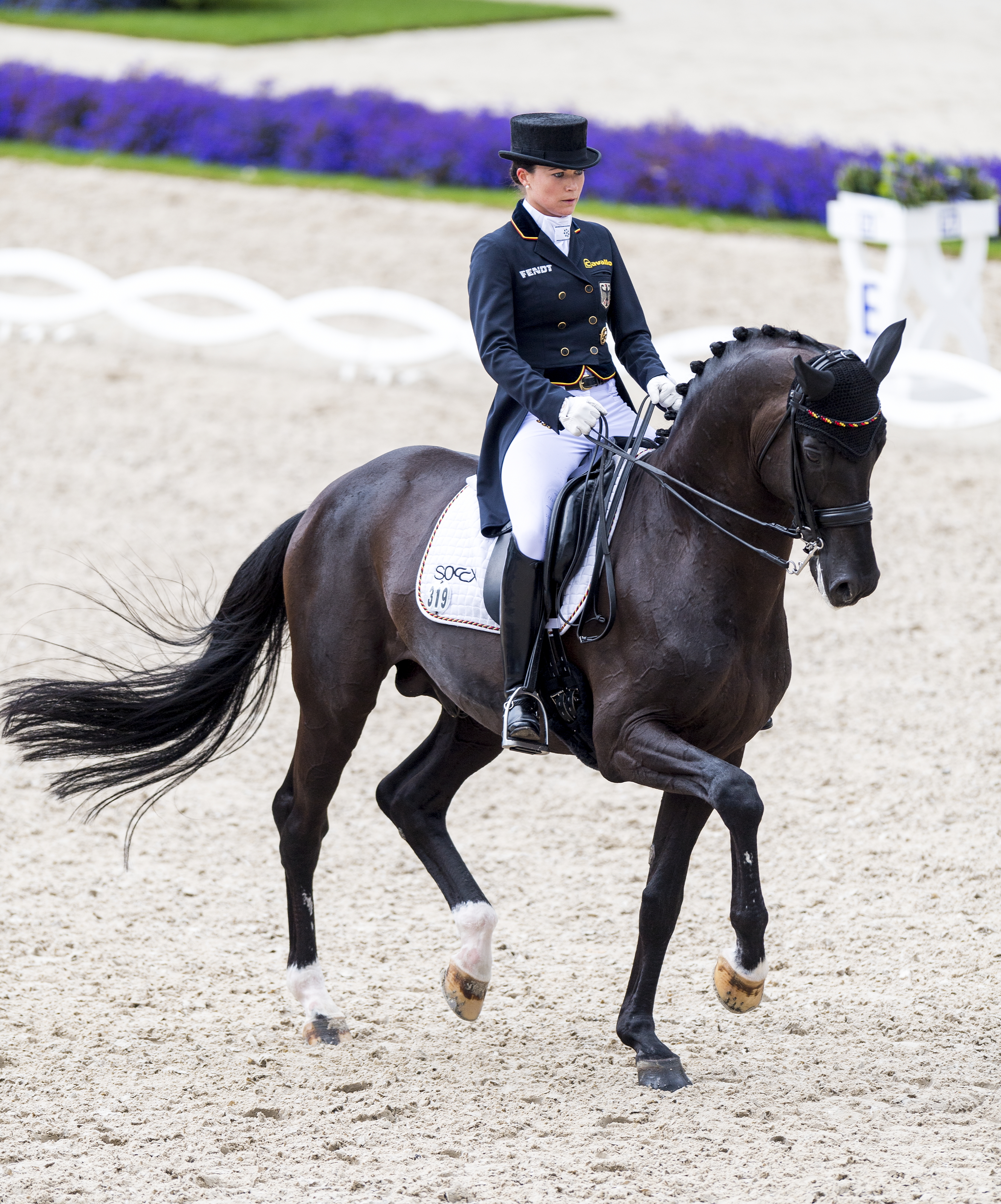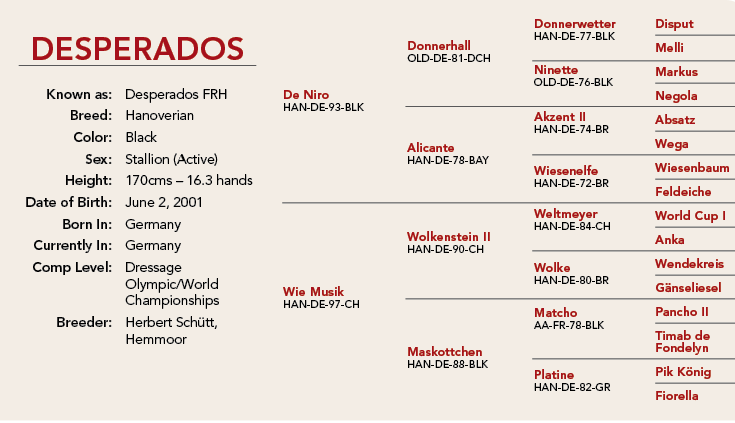
The first horse in our series is the world-famous black stallion, Desperados FRH. Like his sire, De Niro, and grandsire, Donnerhall, before him, Desperados is widely regarded as one of the most influential Hanoverian stallions of the past 40 years. Known for his excellent type, expressive movement and handsome good looks, the 16-year-old is approved for breeding by the Hanoverian Studbook as well as by multiple other warmblood registries. In Germany, more than 30 of his sons have already been licensed as a “Premium” stallions and many of Desperados’ progeny have proven themselves as performance horses around the world. Under his long-time rider, Kristina Bröring-Sprehe of Germany, Desperados has medaled at the Olympic Games, including team gold and individual bronze in Rio, as well as at many other national and international competitions. In 2016, he was named Hanoverian Stallion of the Year by the Hannoveraner Verband.
The Pedigree of a World-Class Horse
Christine Traurig, U.S. Olympian and current Young Horse Coach for the USEF, grew up riding Hanoverians on her parents’ breeding farm in Germany. The farm was located just outside Verden, the riverside town where the Hannoveraner Verband is headquartered and where the world-famous Hanoverian inspections and auctions are held each year. For Traurig, this community and these horses—working the young stock, riding the sale horses, attending the breed inspections and auctions—would become the foundation for her future international success in dressage.

As someone who was (literally) “raised on Hanoverians,” Traurig agreed to guide us through a close reading of Desperados’ pedigree. “First and foremost, Desperados is one of the perfect representatives of the modern dressage horse, not only representing the Hanoverian breed but what all breeding associations and countries are aiming toward,” says Traurig. “He’s elegant and light in type and expression. His movement is elastic, with the scope and adjustability that’s needed for piaffe and passage. And, there’s his temperament—he’s got a great work ethic and is eager to please his rider.”
Traurig says Desperados’ pedigree reflects the predominant breeding strategies utilized by Hanoverian breeders since the 1960s. She explains: “What stands out is the depth of his pedigree in regards to fundamental stallions: Donnerhall, Weltmeyer and Matcho. These stallions are the foundation of the Hanoverian breed moving from past to present.” Traurig points out that De Niro, Desperados’ sire, is one of the most famous and successful sires of dressage horses in the world. A son of the legendary Oldenburg stallion, Donnerhall, De Niro was named Hanoverian Stallion of the Year in 2008. De Niro competed through Grand Prix with international success, as have more than ten of his off-spring. He’s sired six horses that have competed in dressage at the Olympic Games.
Traurig points out the notable influence of the incorporation of “hot blooded” Trakehners, Thoroughbreds and Anglo-Arabs on DeNiro’s pedigree. (He’s 28.13 percent Thoroughbred/Arabian, while Desperados is 15.63 percent “blood.”) On the dam side, De Niro’s pedigree traces back through Alicante to Akzent II, a Hanoverian born in 1975. Akzent II was sired by Absatz, a prolific Hanoverian stallion born in 1960, who was by the Trakehner Abglanz, a stallion who was graded into the Hanoverian studbook in the mid-1900s and whose influence helped to refine the breed. (We see the influence of Absatz on both the sire and dam side of Desperados’s pedigree.) According to Traurig, the influence of hot-blooded horses on traditional stock is responsible for producing the modern dressage horse.
Desperados’ mother, a chestnut mare named Wie Musik, is also a case in point of this approach to sport-horse breeding. Traurig points out Wie Musik is by Wolkenstein II who is by Weltmeyer, both Hanoverian stallions, but Wie Musik’s dam was sired by Matcho, a 16-hand, jet black, French-bred Anglo Arabian who was purchased by the State Stud at Celle specifically to lighten the Warmbloods being bred in Germany in the 1980s and 90s. Traurig explains: “Weltmeyer is one of the most famous stallions in the Hanoverian breed. Over time, it became apparent that his direct offspring were striking in type and basic movement, but often lacked the ‘light-footedness,’ elasticity and adjustability required for upper-level work. In this pedigree, we can see how the influence of Matcho, through his daughter Maskottchen, has modernized the breeding on Desperados’ dam’s side.” Matcho’s daughters are known for not only for their beauty, but also for their ability to improve type and conformation and produce offspring with talent for dressage.
Traurig suggests Desperados epitomizes the result of this approach to breeding the contemporary dressage horse: he’s more refined and lighter than horses of the past, long-legged (especially up front), has an uphill build and refined head. Traurig says, “There’s also his color. For today’s dressage arena, the darker the better!” (She then quickly adds: “But always remember a good horse has no color.”)
In addition to passing on color, general type and exceptional movement, Traurig says Desperados’ offspring are known for their good temperament. His daughter, Doris Day, a Hanoverian mare named Hanoverian Mare Champion in 2010, is a perfect example of Desperados’ ability to stamp his off-spring with his best traits.
The Registry: Hannoveraner Verband
The Hannoveraner Verband is one of the oldest, largest and most influential Warmblood registries. In The International Warmblood Horse, co-author Debbie Wallin writes: “Most of the major Warmblood breeding societies have at least a certain percentage of Hanoverian mares and stallions in their studbooks, the exceptions being those of the Selle Français, the Holstein and the Trakehner.” The Verband has officially regulated the breed since 1922, though the breed’s history goes back much further. According to the Verband’s website: “The beginnings of purposefully breeding Hanoverian horses can be traced back to the 16th century. Breeding horses was an essential basis of existence for the farmers.” Historically, the Hanoverian state owned the stallions and subsidized the breeding programs of modest farmers, who cared for the broodmares (typically also working farm horses) and raised the foals. Over the centuries, the breed adapted many times to the necessities of military and farm life, usually with the introduction of Thoroughbred or Trakehner bloodlines to lighten and refine. Today, the Verband describes the ideal Hanoverian horse as follows: “an excellent to ride, noble, correct and big-framed Warmblood… a partner for sport and pleasure.” Hanoverians stand between 16- and 17-hands high and are noted for their good bone, good feet and refined looks.
The Legacy
If it’s true that Desperados FRH epitomizes the modern dressage horse, it’s also true that his story epitomizes the history of Hanoverian breeding in Germany. Desperados was bred by Herbert Schütt (now in his 80s) in Hemmoor, Germany, on a family farm located 50 miles from Verden. In a 2016 interview, Schütt’s son, Claus, told WBFSH Breeding News: “The family of Desperados FRH has been in my family for almost 100 years. I have a photo of Lacilla (by Lorenz) on a wall in my home, she was born in 1923. The horses from this line were used to work on the farm, but in 1964, my father stopped using them as work horses and kept them for breeding riding horses. I always started the horses and then they were sold, or we kept the better ones for breeding.” The horse Claus refers to, Lacilla, was a registered Hannoverian mare, seven generations back on the dam side of Desperados’ pedigree.
Despite the outstanding success of the Schütt’s breeding program, the family has kept their operation small, breeding just a few horses each year, producing Hanoverians for both dressage and jumping. In a 2012 statement made to the German newspaper Cuxhavener Nachrichten, Schütt recalls his impressions of Desperados as a foal: “Sloping shoulder, correctly positioned legs, glossy black and a picture-perfect face. One recognizes a promising foal right away.” In the same article, Claus commented, “Even as a foal, Desperados looked like a poem.” Today, Desperados FRH is owned by Gestüt Sprehe, a large breeding operation in the Oldenburg region of Germany, and continues to compete under Bröring-Sprehe with exceptional success and longevity on the world stage.
This article first appeared in the February 2018 issue of Dressage Today.











